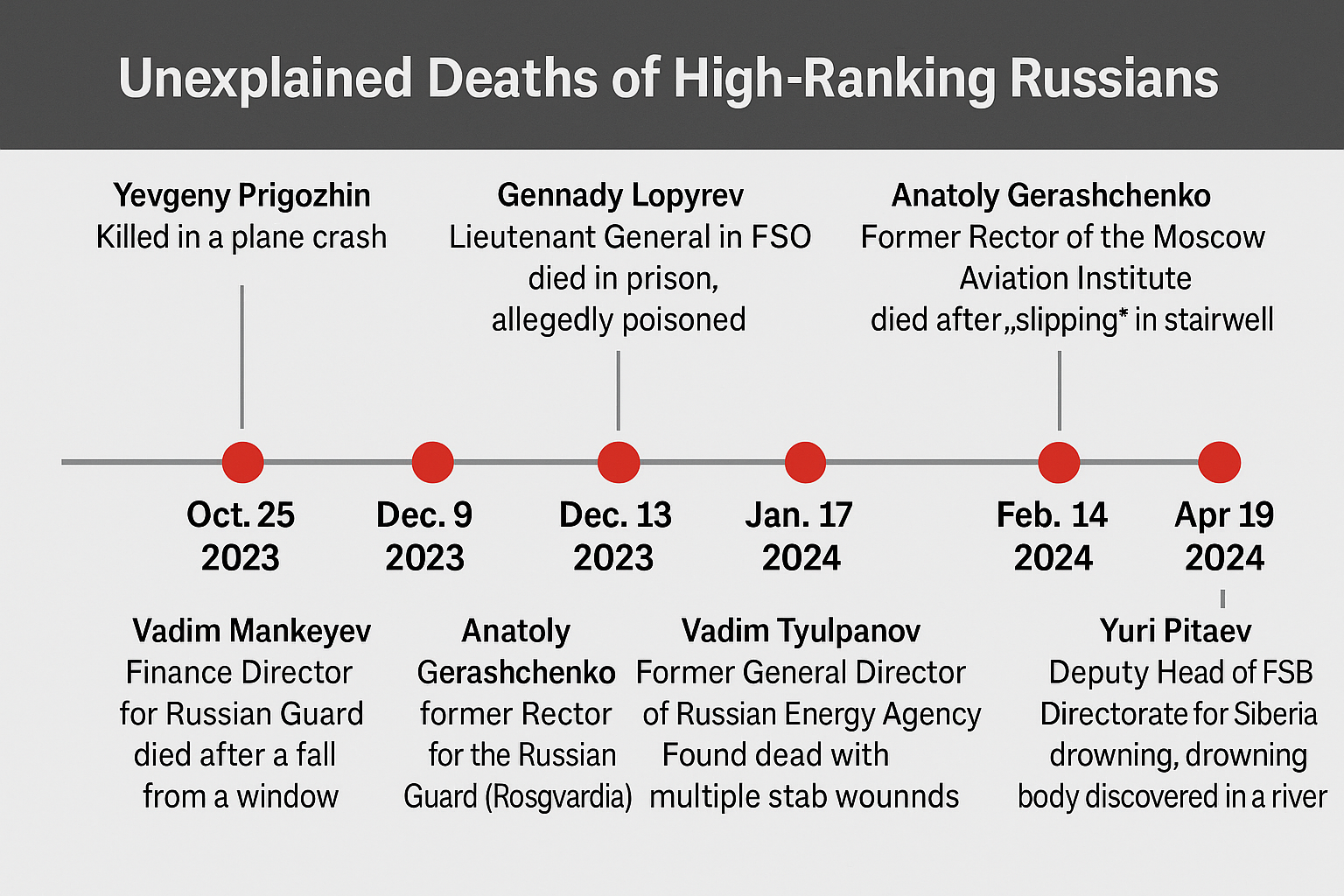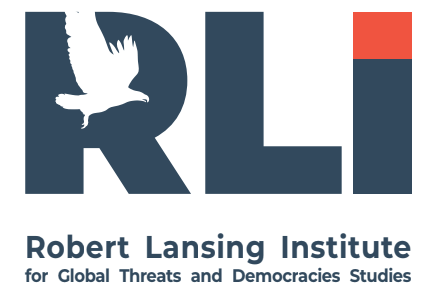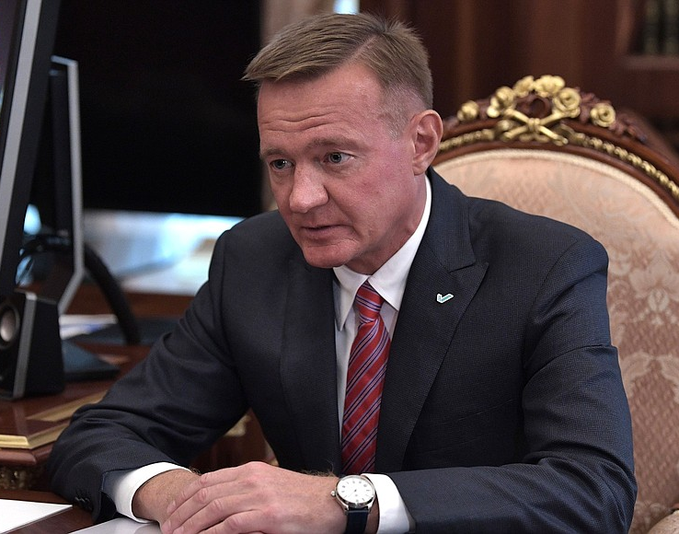Since the beginning of Russia’s full-scale war against Ukraine in February 2022, a disturbing pattern has emerged within the Kremlin’s inner architecture: a wave of unexplained deaths among high-ranking officials, security personnel, and affiliated technocrats. These deaths — ranging from apparent suicides to mysterious accidents — form a coherent picture when seen through the lens of authoritarian consolidation, counterintelligence containment, and elite discipline.
This memo argues that these incidents are neither isolated nor coincidental. Rather, they constitute an unofficial campaign of internal repression, aimed at maintaining loyalty, containing dissent, and eliminating potential security breaches within Russia’s increasingly paranoid wartime power system.

I. The Pattern: Over 20 Dead Officials Since 2022
Between 2022 and mid-2025, at least 20 officials and former security personnel have died under unusual or violent circumstances. Victims include:
- Senior intelligence officers, such as retired SVR generals.
- Financial administrators in the defense and correctional sectors.
- Regional bureaucrats, including deputy governors and city heads.
- Executives with access to sensitive military-industrial or energy infrastructure.
These cases include:
- Suicides by gunshot, hanging, or defenestration.
- Sudden cardiac arrests of relatively young individuals.
- Deaths abroad under ambiguous circumstances (e.g., Cuba, Thailand, India).
- In-prison deaths of once-influential figures convicted in controversial cases.
Unexplained deaths—often by “suicide,” defenestration, poisoning, or mysterious accidents—are frequently a hallmark of elite infighting in authoritarian systems. In Russia’s case, these deaths may reflect:
- Struggles between security services (FSB, GRU, SVR) over influence, corruption networks, or control of operations in Ukraine, Africa, or the Arctic.
- Tensions between Kremlin loyalists and technocrats (e.g., energy executives, IT specialists, or financial managers) who may resist corruption, oppose the war, or have inside knowledge of illegal operations.
- Siloviki rivalries where factions of military, intelligence, and law enforcement elites eliminate internal threats or send messages through targeted killings.
Such incidents, when mapped temporally and contextually, correlate with moments of strategic pressure for the Kremlin — defeats in Ukraine, elite reshuffles, sanctions, and internal power struggles.
II. Beyond Coincidence: Institutional Logic of Intra-Elite Elimination
The Russian state under Putin has long relied on security services as a core mechanism of political control. But since 2022, the traditional methods of co-optation and selective prosecution have increasingly given way to opaque, deniable forms of internal purging.
These deaths serve multiple overlapping functions:
- Counterintelligence containment: Elimination of individuals who possess sensitive knowledge, including those potentially exposed to Western contacts or under suspicion of disloyalty.
- Elite discipline and deterrence: High-visibility suicides function as warnings to others within the system — a method rooted in KGB tradition and reinforced by a culture of impunity.
- Narrative control: By silencing potentially disillusioned or critical insiders, the regime seeks to preempt leaks and reinforce its “no exit” logic: even retirement does not bring safety.
- Preventive neutralization: Officials linked to the financial or logistical failures of the war effort may be removed not through formal prosecution, but via covert retributive action.
The post-2022 Russian state increasingly resembles a counterintelligence autocracy, where internal threats are addressed by operational methods rather than judicial ones. Agencies such as the FSB, SVR, and the Directorate “P” of the MVD are no longer mere information-gathering tools — they are political enforcers, used to preserve the system’s integrity through fear and elimination.
Notably, several of the deceased were:
- Under financial or audit pressure from law enforcement.
- Privy to sensitive state secrets, including war logistics and elite financial networks.
- Expressing private discontent with the war, its aims, or its fallout.
This suggests dual motivation: ideological (eliminating dissent) and operational (containing exposure).
IV. Strategic Consequences and Risks
The ongoing pattern of suspicious deaths has implications for both internal regime dynamics and foreign intelligence assessments:
- Fragmentation of bureaucratic loyalty: The more opaque and arbitrary the system becomes, the less reliable mid-level officials may grow. Paralysis and passivity are likely to spread.
- Decrease in institutional memory: As experienced bureaucrats are purged, retired, or silenced, the continuity of governance — especially in crisis sectors — weakens.
- Escalation of intra-elite paranoia: With no clear rules of survival, elite figures may resort to preemptive betrayals or covert deals abroad — posing new counterintelligence challenges for the West.
- Increased use of opaque violence abroad: The same structures responsible for these internal deaths may expand operations abroad, targeting exiles, dissidents, and former insiders with increased brazenness.
V. Historical and Comparative Frame
This phenomenon recalls:
- Stalin’s post-1937 internal party purges, albeit without show trials.
- The KGB’s use of “silent repression” in the late Soviet period.
- Modern autocracies’ opaque eliminations (e.g., Iran’s IRGC killings of disloyal officers; North Korea’s “disappearance model”).
However, the distinctive feature of Putin’s system is that it maintains a thin veneer of legalism and accident — preserving plausible deniability at all times. This limits domestic outrage and prevents external actors from clearly attributing responsibility.
: When the State Devours Its Own
The Russian elite’s growing exposure to unexplained deaths is not a glitch — it is a governance feature in a system where fear replaces loyalty, and where official death becomes just another tool of vertical control.
For foreign intelligence services and policy planners, this means:
- Treating unexpected deaths as potential signals of regime shifts or fissures.
- Monitoring for patterns that suggest cover-up operations, especially in sectors tied to military-industrial or intelligence outputs.
- Recognizing that some of the Kremlin’s most sensitive secrets may have died with their holders — by design.
3. Post-Prigozhin “Clean-Up” Campaign
After the assassination of Wagner leader Yevgeny Prigozhin in 2023, Putin and the Kremlin likely initiated a broader “re-loyalization” drive. This includes:
- Eliminating Wagner-linked officials;
- Purging individuals suspected of divided loyalties;
- Reasserting fear and obedience within the elite through publicized deaths or disappearances.
The aim is deterrence—warning that disobedience, even silence, is fatal.
4. Kremlin’s Internal Paranoia and Stalinist Echoes
The pattern recalls Stalin-era purges. Putin, increasingly isolated and dependent on shrinking circles of loyalists, may fear:
- A coup attempt;
- Elite betrayal;
- Western infiltration of Russian state structures.
These deaths function as preemptive “cleansing,” not unlike Stalin’s NKVD tactics—combining terror, suspicion, and performance loyalty.
6. Scenarios and Strategic Consequences
Scenario A: Consolidation Through Fear
Putin tightens control by purging any remaining “soft” voices or independent operators. This signals an autocracy leaning toward full-blown dictatorship with unchecked repression.
Scenario B: Systemic Fragmentation
If the deaths are the result of rival factional assassinations, this could signal cracks in the regime. The Kremlin is no longer a monolith, and elite clans may be fighting for influence before Putin’s eventual departure or death.
Scenario C: Controlled Collapse of Covert Networks
The Kremlin may be shutting down or restructuring illegal intelligence, economic, or paramilitary operations (e.g., Wagner offshoots in Africa or Rosatom’s black programs) to minimize risk exposure.
7. Russia’s Vulnerabilities Going Forward
- Erosion of trust among elites, leading to increased secrecy, factionalism, and inefficiency;
- Talent drain, as capable technocrats flee or go silent to survive;
- Western intelligence exploitation, with more defectors or leaked information from those fearing they’re next;
- Instability in military and energy sectors, especially if assassinated officials were critical to logistics or foreign operations.
Conclusion
The wave of unexplained deaths among high-ranking Russians is not random—it is a reflection of a paranoid, decaying power structure, where fear replaces trust and purges replace policy. It is a sign of both regime fragility and Putin’s tightening grip, with major implications for Russia’s internal stability and the conduct of its war in Ukraine and influence abroad.




